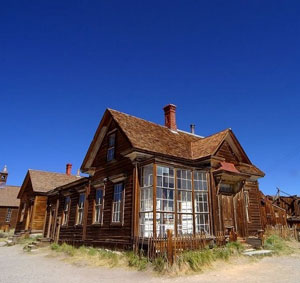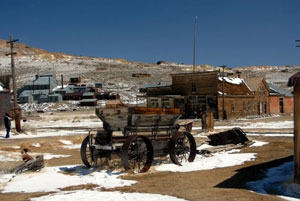|
This series of pictures shows Bodie, Calif., a ghost town on the east flank of the Sierra Madre Mountains. It is one of the stops in the film “Ghost Towns of the Wild West,” which will be presented Saturday, April 2 at 7:30 p.m. in King Concert Hall at SUNY Fredonia.
Tickets are $7.50 for “Ghost Towns of the American West” and are available at the door. The event, which is sponsored by Fredonia Place as part of the Lake Shore Savings Season, is general admission with one child 12 and under admitted free with each adult ticket purchased. |
Local audiences will have the chance to experience the American West through the eyes of a seasoned filmmaker and traveler when the World Travel Series at Rockefeller Arts Center presents “Ghost Towns of the Wild West” on Saturday, April 2 at 7:30 p.m. in King Concert Hall on the SUNY Fredonia campus.
Filmmaker Gray Warriner will personally narrate his work, which will be presented in the high-definition widescreen format.
From the forgotten mining camps at the edge of alpine lakes to the heights of the San Juan Mountains, Warriner’s film offers viewers an up-close look at the real west – as it was more than a century ago and as it is now. With the use of archival photographs, viewers travel back to the late 1800s and then watch the view dissolve, flawlessly, to the same scenes today.
“The search for gold has shaped the west, leaving behind a legacy of riches and abandoned dreams,” Warriner noted.
Part adventure film and part history lesson, “Ghost Towns of the Wild West,” brings that legacy to life during stops in California, Colorado, Montana, Nevada, Oregon, Utah and Washington. Footage of panoramic landscapes and frontier towns converges with true tales of the old West that prove to be even wilder than the popular fictional accounts which they inspired.
Warriner follows the trails that were established by the fortune seekers who headed west as part of the mass migration that began with the discovery of gold in California in 1849.
In the gold fields, Warriner noted that “the mother lode country of California played no favorites,” citing tales of Chinese coulees – unskilled laborers who came to the West to find work – uncovering fortunes and building grand temples reminiscent of those in their homeland.
It is in California that Warriner takes viewers to what he terms the “best preserved ghost town in the West,” – Bodie.
Named for prospector William Bodie (who ironically died in a snowstorm before the big mining strike was made), Warriner said Bodie stands “frozen in time” and represents the best and worst of the wild West. At its peak, Bodie boasted 65 saloons and more than 10,000 residents, making it the second largest city in California at the time.
Warriner’s “history lesson” is interspersed with humor, as he reveals the dry wit of early settlers in the naming of their towns. The settlement of Dog Town in California earned its name as inhabitants decided the place was “not fit for a dog,” while Malakoff Diggens, another mining settlement in California, was originally called “Humbug” because its initial deposits disappointed miners.
Like Bodie, many of the boom towns now lay as dormant reminders of another era. However, Warriner’s film highlights others that still have life in the modern age – including Virginia City, Nev., which was born in 1859 as the result of a silver strike known as the Comstock Lode.
In its boomtown days of the 1860s, Virginia City mines helped finance the Union effort during the Civil War. The city could also lay claim to being the birth place of Mark Twain, as a young Samuel Clemens first used his famous pen name while writing for one of the city’s newspapers in 1876.
“Ghost Towns of the Wild West” also pays tribute to the pioneering spirit and the burgeoning industrial revolution that made great engineering feats possible in the gold fields.
Traveling by narrow gauge railroad and by Jeep trails, Warriner heads high into the Rockies to capture images of Colorado’s “Hanging Flume” – a prime example of just such an engineering feat.
A flume, in basic terms, is a ditch used by miners to feed water into a channel for washing away sediment and uncovering gold. This description, however, does not do justice to The “Hanging Flume,” which was seven miles long and capable of carrying eight million gallons of water a day.
This flume was chiseled into sheer cliffs hundreds of feet above the Dolores River. Workers on the project had to be lowered down from a cliff 500 feet above the work zone. While the life of this flume was short – it was only in operation for two years – Warriner noted that it stands as a “statement in stone” to perseverance.
Throughout the West, Warriner noted the ghost towns stand as reminders that it was not the end that was important, but the journey.
“The real reward was just being there,” he said. “There was an untethered freedom reflected in the raw beauty of the land.”
Warriner is an independent producer of documentaries and travelogues. He has worked as a cameraman, director and producer. Along the way, he has won more than 80 national and international awards for film excellence, including Eastman Kodak’s award for best film.
For the past 20 years, Warriner has headed Camera One, a Seattle-based production company that specializes in educational and adventure/travel films. He has created films for many of the National Park System’s visitor centers. In addition to working as a professional filmmaker, Warriner was also an instructor of cinematography at the University of Washington.
Tickets for “Ghost Towns of the American West” are available at the door. The event, which is sponsored by Fredonia Place as part of the Lake Shore Savings Season, is general admission with one child 12 and under admitted free with each adult ticket purchased.





